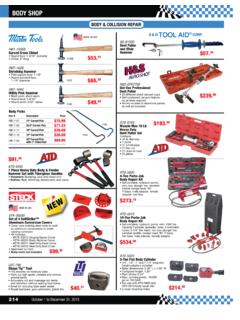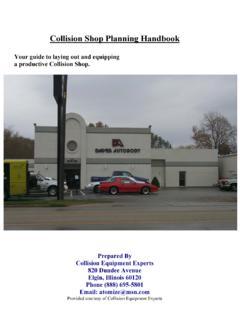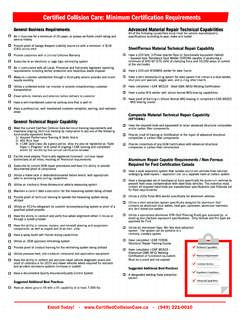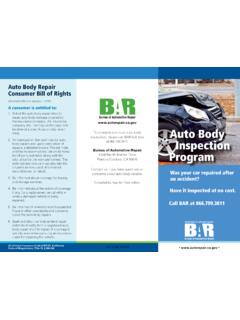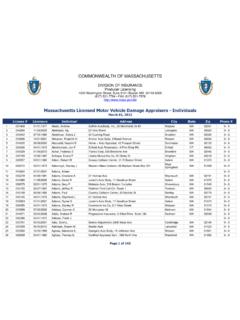Transcription of Specification Data For Pipe Guards (Bollards)
1 Specification data For pipe Guards ( bollards ) With increasing threats vehicle barriers are becoming more popular at many facilities such as gas stations, shopping malls, and restaurants etc., to protect people and property. This preliminary report focuses on the technical nature of the construction of pipe Guards , also known in the industry as bollards . bollards are U-shaped steel forms which are hollow on the inside. They are used as barriers to vehicle collisions. Based on crash test data , a passenger car of average size weighing tons (2400 lbs) traveling at 40 mph will generate a force during impact equivalent to 50 tons, when it strikes a bollard.
2 Commonly, bollards are specified with a 4-inch diameter, filled with concrete, and set into the ground at a depth of 12 inches. This Specification is not based on any reported scientific data , but instead has just been used in the industry as a common standard. Clearly, with the forces generated during a vehicle collision , a quantitative analysis must be performed to specify a properly designed bollard system A bollard s ability to properly stop a vehicle is a function of several variables. These are the diameter of the pipe , the wall thickness, the height above ground, the depth into the ground, the area of the base, the soil and concrete type of the base, the structural properties of the steel, the vehicle speed and mass, and the whether or not concrete is used to fill the bollard.
3 The most extensive tests on bollard design specifications are based on the United States Department of State guidelines for protecting government facilities. This standard is and it specifies the vehicle crash test limits for bollards . Examples of design parameters and a general introduction of the equations used to model these standards are described below. The capacity to stop a vehicle is based on equations that describe the collision of vehicles into a structure such as a bollard that are found in the fundamental laws of physics.
4 The kinetic energy (KE) of a vehicle moving at a certain velocity (v) with a mass (m) is given by: 221mvKE= This kinetic energy is equated to the force a bollard can withstand times its distance of deflection. The defection is the distance the bollard will be penetrated by the vehicle. This equation is: ceDisxForceKEtan= Usually the deflection distance is specified by the Department of State standards, so the actual construction of the bollard is designed to meet the force requirements. An example of the vehicle deflection is shown on the following figure.
5 This type of collision is called an inelastic collision , where the momentum (p) of the vehicle equals the momentum gained by the bollard, as shown in the following equation. mvp= Where the bollard deflects a certain distance very quickly, stopping the vehicle. Bollard integrity is related to two main materials of construction, the concrete fill and the steel used. The compressive strength of the concrete resists the shear force generated by vehicle impact, as well has providing a load distribution throughout the bollard structure.
6 The steel bollard resists buckling due to vehicle impact, and cracking of the concrete. By combining these two together, a bollard can be designed to give excellent protection due to vehicle impacts. As mentioned previously, most bollard specifications are specified at a 4-inch diameter. When filled with concrete and supported properly in the ground, this type of bollard can be used to stop a slow moving vehicle travelling at a speed of 5 mph. At higher speeds a larger diameter bollard filled with concrete is required. For example an 8-inch diameter bollard filled with concrete and supported properly can stop a vehicle moving in excess of 50 mph.
7 With gas stations so close to the road, this should not be overlooked, as a serious vehicle impact could cause quite a devastating fire if the vehicle were to hit the gas dispenser pumps. Specific design criteria follow for bollard design. The following standards and requirements are governed by the Department of State for the implementation of vehicle barriers. Additional standards and requirements can be found in the Specification for Vehicle Crash Test of Perimeter Barriers and Gates and 12 FAH 5, Foreign Affairs Handbook.
8 These guidelines for structural integrity parallel the requirements for the prevention of vehicle collision with fuel dispensers throughout the petroleum industry. These types of barriers may be U-shaped pipe Guards or other types of bollards as well. At minimum, each manufacturer must have one vehicle barrier tested and certified by DOS prior to the award of contract. The standard given by the DOS ( ) specifies perpendicular barrier impact by a 15,000 lb. (6810 kg) vehicle. The ratings required by the DOS ( ) are represented by combined K and L values, where K indicates the DOS certified barrier s maximum vehicle impact speed rating and L indicates the test vehicle s distance of penetration upon impact with a barrier and are given by K#/L#: K12 = 50 mph (80kph) L3 = 3 ft.
9 (915 mm) or less K8 = 40 mph (65kph) L2 = 3 ft. to 20 ft. (915 mm to m) K4 = 30mph (48 kph) L1 = 20 ft. to 50 ft. ( m to m) All vehicle barriers shall be made of: Steel: Deformed steel reinforcement shall be new billet steel, Grade 60 (for forced entry designs) and Grade 40 (for anti-ram designs) and shall comply with American Concrete Institute standard (ACI) 318 and American Society of Testing Materials standards (ASTM) A-615. Placement of reinforcement shall be governed by ACI 318. Placing plans and shop details shall be in accordance with ACI 315 and shall be provided as shop drawings during the installation.
10 Furnish support bars in accordance with CRSI standards. Structural steel shall be carbon steel (ASTM A-36) having a minimum tensile strength of 400 to 550 Mpa. All structural steel shall be designed in accordance with the American Institute of Steel construction (AISC) Specification for Design, Fabrication, and Erection of Structural Steel for Buildings. The pipe shall be 7 ft in length, with a minimum of 8 in (200mm), and a wall thickness of in (12mm). The portion of the bollard at grade is susceptible to corrosion from exposure to standing water.

